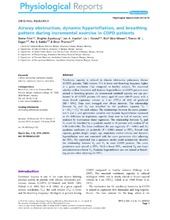| dc.contributor.author | Frisk, Bente | en_US |
| dc.contributor.author | Espehaug, Birgitte | en_US |
| dc.contributor.author | Hardie, Jon Andrew | en_US |
| dc.contributor.author | Strand, Liv Inger | en_US |
| dc.contributor.author | Moe-Nilssen, Rolf | en_US |
| dc.contributor.author | Eagan, Tomas Mikal | en_US |
| dc.contributor.author | Bakke, Per | en_US |
| dc.contributor.author | Thorsen, Einar | en_US |
| dc.date.accessioned | 2014-12-19T14:20:52Z | |
| dc.date.available | 2014-12-19T14:20:52Z | |
| dc.date.issued | 2014-02-01 | eng |
| dc.identifier.issn | 2051-817X | |
| dc.identifier.uri | https://hdl.handle.net/1956/8998 | |
| dc.description.abstract | Ventilatory capacity is reduced in chronic obstructive pulmonary disease (COPD) patients. Tidal volume (VT) is lower and breathing frequency higher at a given ventilation (VE) compared to healthy subjects. We examined whether airflow limitation and dynamic hyperinflation in COPD patients were related to breathing pattern. An incremental treadmill exercise test was performed in 63 COPD patients (35 men), aged 65 years (48–79 years) with a mean forced expiratory volume in 1 sec (FEV1) of 48% of predicted (SD = 15%). Data were averaged over 20-sec intervals. The relationship between VE and VT was described by the quadratic equation VT = a + bVE + cVE² for each subject. The relationships between the curve parameters b and c, and spirometric variables and dynamic hyperinflation measured as the difference in inspiratory capacity from start to end of exercise, were analyzed by multivariate linear regression. The relationship between VE and VT could be described by a quadratic model in 59 patients with median R2 of 0.90 (0.40–0.98). The linear coefficient (b) was negatively (P = 0.001) and the quadratic coefficient (c) positively (P < 0.001) related to FEV1. Forced vital capacity, gender, height, weight, age, inspiratory reserve volume, and dynamic hyperinflation were not associated with the curve parameters after adjusting for FEV1. We concluded that a quadratic model could satisfactorily describe the relationship between VE and VT in most COPD patients. The curve parameters were related to FEV1. With a lower FEV1, maximal VT was lower and achieved at a lower VE. Dynamic hyperinflation was not related to breathing pattern when adjusting for FEV1. | en_US |
| dc.language.iso | eng | eng |
| dc.publisher | Wiley | eng |
| dc.publisher | American Physiological Society | eng |
| dc.relation.ispartof | <a href="http://hdl.handle.net/1956/10342" target="blank">Exercise capacity and breathing pattern in patients with chronic obstructive pulmonary disease. Predictors and longitudinal changes</a> | |
| dc.rights | Attribution CC BY | eng |
| dc.rights.uri | http://creativecommons.org/licenses/by/3.0/ | eng |
| dc.subject | Chronic obstructive pulmonary disease | eng |
| dc.subject | Exercise | eng |
| dc.subject | inspiratory capacity | eng |
| dc.subject | spirometry | eng |
| dc.title | Airway obstruction, dynamic hyperinflation, and breathing pattern during incremental exercise in COPD patients | en_US |
| dc.type | Peer reviewed | |
| dc.type | Journal article | |
| dc.description.version | publishedVersion | en_US |
| dc.rights.holder | Copyright 2014 The Authors | |
| dc.source.articlenumber | e00222 | |
| dc.identifier.doi | https://doi.org/10.1002/phy2.222 | |
| dc.identifier.cristin | 1220150 | |
| dc.source.journal | Physiological Reports | |
| dc.source.40 | 2 | |
| dc.source.14 | 2 | |

